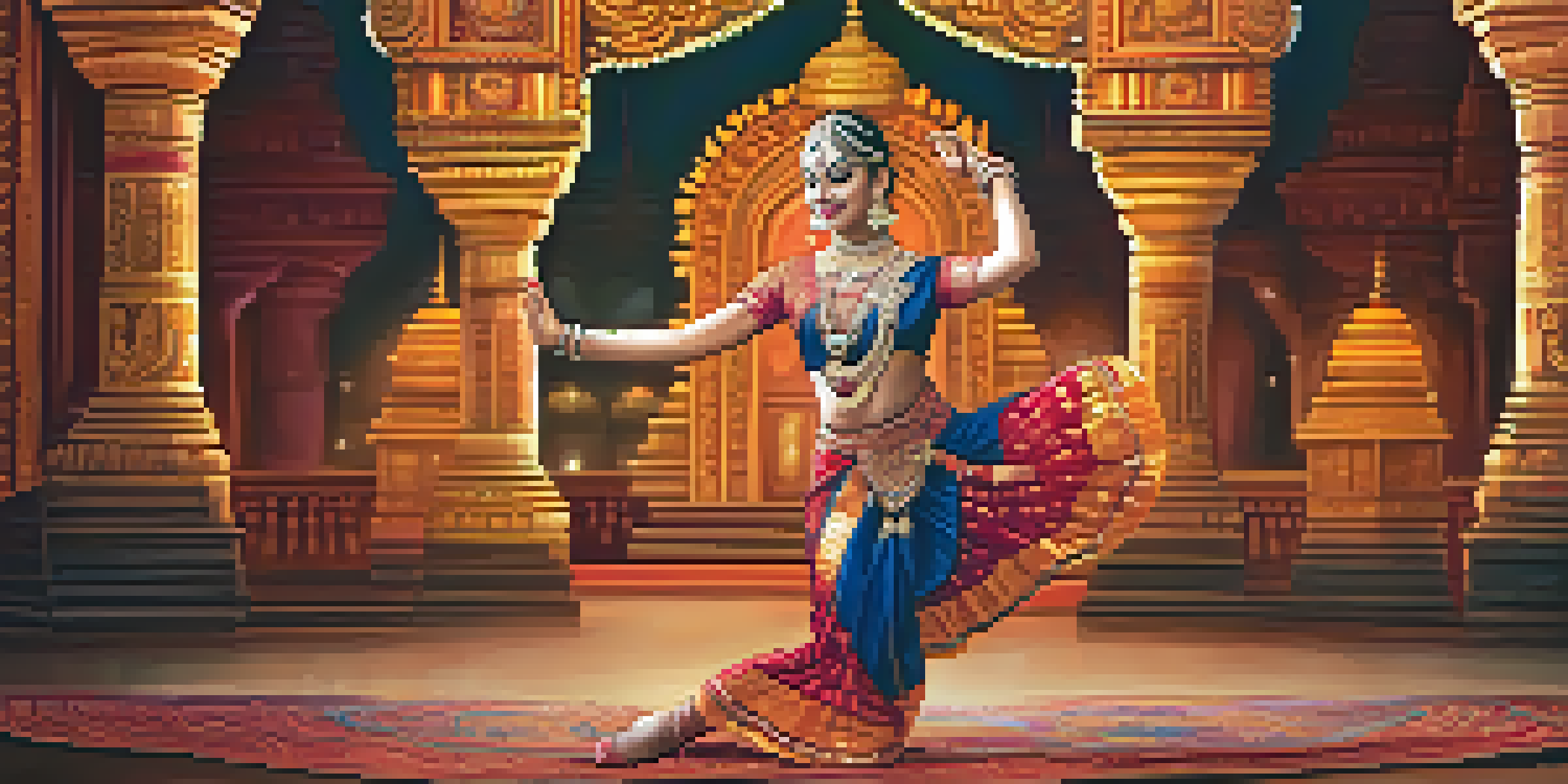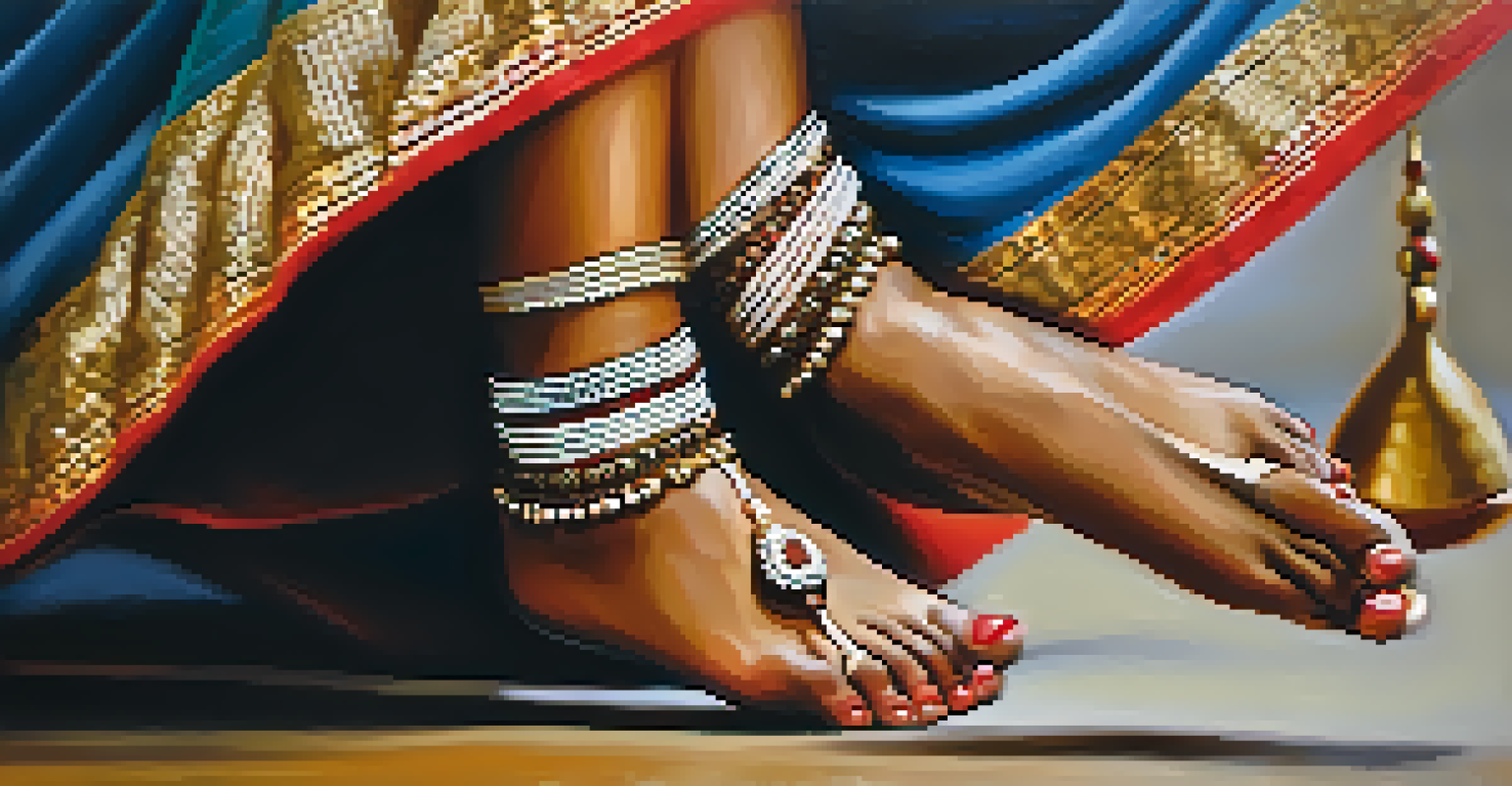Bharatanatyam: The Evolution of a Classical Indian Dance Form

The Origins of Bharatanatyam: A Cultural Heritage
Bharatanatyam, one of the oldest classical dance forms of India, traces its roots back over 2,000 years to the temples of Tamil Nadu. It was originally performed by Devadasis, women dedicated to temple service, who used dance as a means of worship. The dance reflects a blend of spiritual expression and artistic beauty, showcasing intricate footwork and expressive gestures.
Dance is the hidden language of the soul.
In its early days, Bharatanatyam was not just an art form but a medium for storytelling, often depicting tales from Hindu mythology. The dancers would narrate these stories through a combination of facial expressions, hand gestures (known as mudras), and rhythmic movements. This deep connection to spirituality and storytelling has always been a cornerstone of Bharatanatyam.
However, with the decline of the temple system during the British colonial period, Bharatanatyam faced challenges. It was deemed inappropriate and fell into obscurity, leading many to believe that this rich tradition might fade away entirely.
Revival in the 20th Century: A New Era for Bharatanatyam
The revival of Bharatanatyam in the early 20th century was nothing short of miraculous. Pioneers like Rukmini Devi Arundale played a crucial role in re-establishing its significance and elevating it to a respected art form. She transformed Bharatanatyam from a temple dance to a stage performance, giving it a new identity while preserving its essence.

Rukmini Devi introduced innovative changes, including new costumes and music compositions, which made the dance more accessible to wider audiences. Her efforts not only brought Bharatanatyam back into the limelight but also encouraged more women to pursue dance professionally. This shift marked a turning point in the journey of Bharatanatyam.
Bharatanatyam's Rich Cultural Roots
Originating over 2,000 years ago in Tamil Nadu, Bharatanatyam was initially performed by Devadasis as a form of worship, intertwining spirituality and storytelling.
The increased acceptance and appreciation of Bharatanatyam during this period paved the way for numerous dance schools and institutions. This led to a formalization of training methods, ensuring that the intricacies of the dance were preserved and passed down through generations.
The Elements of Bharatanatyam: A Dance of Precision
Bharatanatyam is known for its distinctive features, including elaborate footwork, intricate hand gestures, and expressive facial expressions. Each element plays a vital role in conveying emotions and stories, making the dance a captivating experience for audiences. The precision involved in every movement is akin to a carefully crafted symphony, where each note counts.
Art is the most beautiful of all lies.
The dance is divided into several components, including Alarippu (invocation), Jatiswaram (pure dance), and Varnam (thematic piece), each contributing to the overall narrative. The seamless transition between these sections requires rigorous training and immense dedication, showcasing the dancer's skill and artistry. Think of it as a journey where every step reveals a new chapter.
Moreover, the music that accompanies Bharatanatyam adds another layer of depth. Traditionally, live musicians play classical Carnatic music, enriching the performance with rhythm and melody. This harmonious blend of music and dance creates a holistic experience, captivating audiences and drawing them into the enchanting world of Bharatanatyam.
Bharatanatyam Today: A Global Phenomenon
In recent years, Bharatanatyam has transcended geographical boundaries, captivating audiences worldwide. International dance festivals and cultural events frequently feature this art form, showcasing its universal appeal. Dancers from diverse backgrounds have embraced Bharatanatyam, infusing it with their unique interpretations and styles.
This globalization of Bharatanatyam has led to a fascinating fusion of traditional and contemporary elements, resulting in innovative performances. Many artists are exploring themes that resonate with modern audiences, addressing social issues and personal narratives through the dance. It’s a beautiful evolution, much like how a river flows and adapts to its surroundings.
Revival and Global Expansion
In the 20th century, Bharatanatyam experienced a revival through pioneers like Rukmini Devi, transforming it into a respected stage performance that now captivates audiences worldwide.
Despite its global reach, the core values and traditions of Bharatanatyam remain intact. Dancers continue to honor the cultural heritage and spiritual essence that the dance embodies, ensuring that its roots are never forgotten. This balance between tradition and innovation is what makes Bharatanatyam a living art form, continually evolving while remaining deeply connected to its origins.
The Role of Technology in Bharatanatyam
The advent of technology has significantly impacted the way Bharatanatyam is taught, performed, and appreciated. Online platforms have made it easier for aspiring dancers to access tutorials and masterclasses from renowned artists. This shift has democratized learning, allowing people from all walks of life to engage with this beautiful art form.
Moreover, social media has become a powerful tool for dancers to showcase their talents and reach a global audience. Many dancers now share their performances on platforms like Instagram and YouTube, creating a vibrant community of enthusiasts. This visibility not only helps promote Bharatanatyam but also inspires a new generation of dancers.
However, the integration of technology also presents challenges. Some purists worry that the essence of Bharatanatyam might be diluted in the rush to modernize. Striking a balance between embracing new tools while preserving traditional values will be crucial for the future of Bharatanatyam in a rapidly changing world.
The Influence of Bharatanatyam on Other Dance Forms
Bharatanatyam’s influence extends beyond its own boundaries, impacting various other dance forms both in India and globally. Many contemporary dancers draw inspiration from Bharatanatyam’s intricate movements and storytelling techniques, blending them with modern styles. This cross-pollination of ideas enriches the overall dance landscape, creating a tapestry of movement and expression.
For instance, some Western dance forms have incorporated Bharatanatyam's mudras and footwork, leading to innovative choreographies that celebrate cultural fusion. This kind of collaboration highlights the universality of dance as a means of communication, transcending linguistic and cultural barriers. It's a bit like how different ingredients come together to create a delightful dish.
Challenges and Future Opportunities
As Bharatanatyam evolves, it faces the challenge of maintaining its traditions while embracing contemporary influences, presenting opportunities for cultural exchange and innovation.
Additionally, Bharatanatyam has found its way into popular culture, appearing in films, music videos, and theatrical productions. This exposure has not only popularized the dance but also sparked interest in its traditional roots. As Bharatanatyam continues to inspire new generations, its legacy as a foundational dance form remains strong.
The Future of Bharatanatyam: Challenges and Opportunities
As Bharatanatyam moves forward, it faces both challenges and opportunities in a rapidly changing world. The challenge lies in maintaining the rich traditions while adapting to contemporary sensibilities. Dancers and educators must find innovative ways to keep the art form relevant without compromising its core values, much like balancing a delicate scale.
On the other hand, the growing interest in cultural exchange and diversity presents an opportunity for Bharatanatyam. Collaborations with artists from different backgrounds can lead to exciting new interpretations and performances. This not only showcases the adaptability of Bharatanatyam but also emphasizes the importance of cultural dialogue in the arts.

Ultimately, the future of Bharatanatyam will depend on the commitment of its practitioners to honor its heritage while embracing change. As long as there are passionate dancers and audiences who appreciate its beauty and depth, Bharatanatyam will continue to thrive and evolve, dancing its way into the hearts of many.